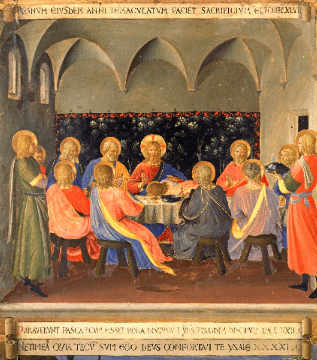Chronological list of the most important RENAISSANCE LAST SUPPERS
in FLORENCE:
1 - Taddeo Gaddi, 1360 - Santa Croce monastery refectory, lowest part of a Tree of Jesse and Crucifixion with side scenes from saints' lives. Judas is on the opposite side of the table from Christ.
2 - Orcagna, 1370 - damaged Last supper (only two apostles left), Refectory of Santo Spirito.
3 - Fra Angelico -1445-1452 - 3 Last Suppers (2 are really the subject Institution of the Eucharist),
1 in cell 35 in monastery of San Marco, 2 on the church calendar panel in Museo di San Marco.
Cell 35 - Last Supper with Mary, Christ's mother, kneeling.
4 - Castagno, 1447 - Sant'Apollonia, refectory of the convent.
5 - Ghirlandaio - 1480 - Ognissanti refectory, Ognissanti
Ghirlandaio - 1482- San Marco refectory

6- Perugino -1494 - Last Supper for refectory of convent of Fuligno, Florence.
7 - Franciabigio, 1514, Last Supper for Convitto della Calza (convent refectory), Florence.
8 - Andrea del Sarto -1519-27 - San Salvi refectory, just outside Renaissance walls of Florence.
9 - Francesco Allori, Last Supper, refectory, Chiesa del Carmine, 1582.
Taddeo Gaddi seems to begin the tradition in Florence of placing Judas on the opposite side of the table from Christ, a tradition followed by Castagno, Ghirlandaio, Perugino, Franciabigio, and only stopped by Leonardo in his Last Supper in Milano which influences Del Sarto and in Florence after him. The Florentines except for Fra Angelico like the tradition of placing the remaining apostles on the same side of the table so that their faces can easily be discerned along with their reactions to the announcements. All the Florentine examples, except for Fra Angelico's, are painted for ecclesiastical dining halls, mirroring the activity of the monks or nuns gathering for meals.
The lifelike quality of the Last Suppers after Orcagna can be attributed to the use of
one-point perspective and careful study of anatomy and realistic light sources. The only animals in
the Florentine examples are the birds and peacock in Ghirlandaio's Ognissanti fresco and the cat
and peacock in his San Marco fresco.















No comments:
Post a Comment